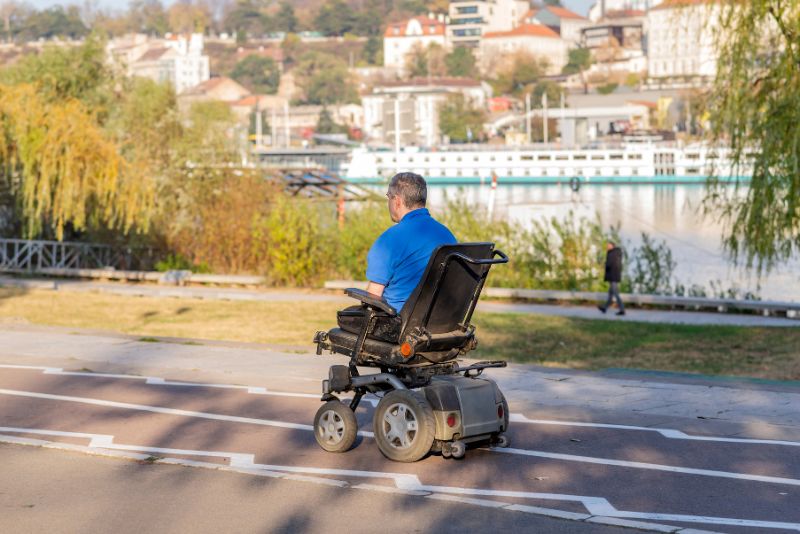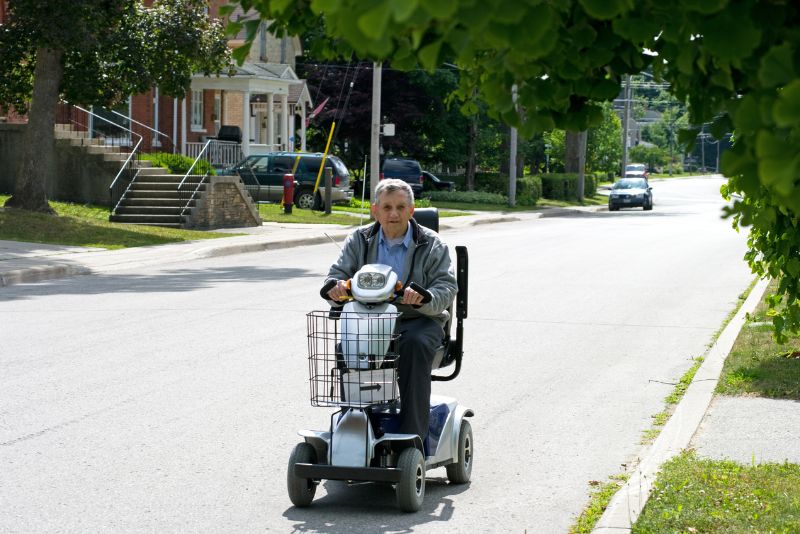How Far Can Electric Wheelchairs Go? Understanding Range And Factors Affecting Distance
Posted by Tom Lee on
Wondering how far an electric wheelchair can take you? On average, a fully charged power wheelchair travels about 10 to 20 miles. Our article will guide you through the factors that influence this range.
Ready for some insights? Keep reading.
Key Takeaways
- Electric wheelchairs can travel between 3 to 25 miles on one full charge, depending on factors like design and use.
- Terrain, user weight, driving habits, and wheelchair maintenance all impact how far the chair can go.
- Choosing the right make and model of electric wheelchairs is crucial for meeting individual distance needs. High-quality batteries and tires boost performance.
- Keeping a steady speed instead of stopping and starting saves battery power, helping users cover longer distances.
- Regular checks on tire pressure and battery health extend a wheelchair’s range and ensure it remains in top condition for travel.
Understanding Range for Electric Wheelchairs

Electric wheelchairs can travel a surprising distance on just one full charge—anywhere from 3 to 25 miles. The actual range depends on various factors, like the wheelchair’s design and how it’s used.
General range estimates (3-25 miles)
Electric wheelchairs can travel between 3 and 25 miles on a single charge. This range varies widely, influenced by several important factors, including the wheelchair’s design and battery capacity.
Some models offer about 8-10 miles per full charge, while higher-end wheelchairs may exceed this average, reaching up to 25 miles.
Factors like terrain, user weight, and driving habits also play crucial roles in determining how far an electric wheelchair can go. Consistent speed and smoother surfaces typically result in longer distances covered before needing a recharge.
Each wheelchair has specific capabilities that define its maximum range under optimal conditions.
Factors that affect the range
Many factors influence how far an electric wheelchair can travel. The wheelchair brand and model are huge determinants—some chairs have better batteries and more efficient motors, allowing longer trips.
A heavier frame means the motor works harder, reducing range. Also, higher-priced models often come with enhancements that support extended use.
User actions are a role, too. Someone’s weight adds to the chair’s load, possibly shortening travel distance. How a person drives—fast speeds and frequent stops—and their choice of terrain impact battery life.
Smooth surfaces are less draining than rough terrain. Regular maintenance keeps the chair running farther; poorly kept batteries or under-inflated tires limit the ground you can cover.
Wheelchair-Specific Factors

The type of electric wheelchair you have plays a big role in how far it can go. Everything from its design to the kind of tires and battery power it has affects the distance.
Brands and model
Different brands and models of electric wheelchairs offer varying ranges. Some can travel up to 25 miles on a single charge, while others may only cover 3 miles. This significant variation stems from each model’s design, including the type of battery used—lead-acid or lithium—and overall efficiency.
Choosing the right brand and model becomes crucial for users needing a wheelchair for longer distances.
Battery type is the key to determining how far an electric wheelchair can go. Models equipped with lithium-ion batteries often provide longer range and durability than those with lead-acid counterparts.
Users should consider their daily usage needs when selecting a power chair to ensure it matches their mobility requirements, considering both the potential distance per charge and the battery’s longevity.
Tires
Tires play a crucial role in an electric wheelchair’s performance. Improved casters and drive wheel tires can boost the range of high-strength lightweight wheelchairs. This upgrade means smoother rides and potentially longer distances covered on a single charge.
The type of tire—whether solid, pneumatic, or foam-filled—affects how the wheelchair handles different terrains.
The market for electric wheelchair tires is expanding due to their impact on mobility and range. Choosing the right tires can make a big difference for users looking to maximize their freedom and independence.
Solid tires offer durability without the risk of punctures, while pneumatic tires provide better shock absorption for a more comfortable ride over rough surfaces. Each choice impacts how far you can go with your electric wheelchair, making it important to consider your typical journey and terrain when selecting tires.
Battery power
Battery power is key for how far an electric wheelchair can go. A basic 12-volt battery might last for up to 6 miles. If you have a 24-volt series, expect it to last up to 20 miles.
On average, a fully charged power wheelchair travels about 10 to 20 miles. Always check your battery’s charge before heading out. You don’t want to get stranded without power.
Keeping your battery in good shape helps, too. Charge the battery as recommended—don’t overcharge or let it run too low often. This care extends its life and ensures you can cover longer distances when needed.
Think of your electric wheelchair’s battery like a car’s fuel tank—the better you maintain it, the further you’ll go.
User-Related Factors
Who you are and how you drive matters a lot. Your weight and driving style affect how far your electric wheelchair can go.
User’s weight
The user’s weight greatly affects how far an electric wheelchair can go. Lighter users mean the wheelchair uses less power to move, leading to longer distances on a single battery charge.
On the other hand, heavier users require more movement power, which can shorten travel distance. Staying within the weight capacity is crucial for safety and ensures the electric wheelchair performs well.
Exceeding the electric wheelchair’s weight limit risks its stability and structure. It’s important for users to know their chair’s limits. Keeping extra weight off helps achieve maximum speed and distance, making every trip efficient and safe.
Proper use according to weight guidelines prevents damage, ensuring long-term reliability and performance of the electric wheelchair.
Driving habits
Driving habits directly impact how far an electric wheelchair can travel. Frequent starts and stops or speeding consumes more battery power than maintaining a steady pace. Consistent driving conserves energy, extending your chair’s distance on a single charge.
Similarly, aggressive maneuvers and constantly changing speeds reduce overall range. Practicing efficient driving techniques can significantly increase the miles you get from your motorized wheelchair.
Understanding these habits is crucial for maximizing mobility and independence. Sideways tips and forward falls are less about speed and more about curb height and approach angle—making cautious navigation key in unfamiliar environments.
By focusing on smooth transitions and avoiding abrupt changes in direction or speed, users ensure they go as far as possible without compromising safety or performance.
Speed
The weight of the user affects how fast an electric wheelchair can go. Most chairs travel at about 5 miles per hour. Some models, designed for higher speeds, can move faster. This means choosing a power wheelchair requires thinking about speed needs.
Higher speeds offer quicker travel but also demand careful handling. Users must balance the need for speed with safety and control, especially in crowded or tricky areas. Before purchasing an electric wheelchair, consider how fast you need to travel.
Journey-Related Factors
The type of terrain and whether you drive in stop-start traffic or at a consistent speed can greatly influence how far your electric wheelchair goes—explore more to understand all the factors at play.
Terrain
Rough and uneven surfaces challenge electric wheelchairs, draining batteries faster than smooth paths do. Wheelchairs must work harder on bumpy roads or inclines, reducing travel distance.
Designers of these chairs think a lot about how they will be used in different places to make sure they’re as efficient as possible, even on tough terrain.
Next, consider what happens when you stop and start frequently versus keeping a consistent speed.
Stop-start vs. consistent speed
Just like the terrain impacts how far an electric wheelchair can go, so does how you drive it. Driving at a constant speed is more battery-friendly than stop-start movement. This means your chair will take you farther if you keep a steady pace instead of speeding up and slowing down frequently.
Studies show driving smoothly without too many starts and stops uses less power. Planning your route to avoid heavy traffic areas or places where you have to stop often can help extend your battery life, which means going longer distances on a single charge.
Keep it steady, and enjoy exploring more places with ease.
Maintenance Factors
Keeping your electric wheelchair in top shape is key—regular checks on tire pressure and battery health can significantly boost its range. Want to learn more? Keep reading!
Tire pressure
Tire pressure is key to how far your electric wheelchair can travel. Properly inflated tires, usually between 40 and 50 PSI, help maximize the distance you can cover. They reduce rolling resistance, making your chair move forward easier.
To ensure your electric wheelchair goes the distance, regularly check tire pressure. This simple step keeps the ride smooth and extends battery life by lessening the effort to cruise or tackle inclines.
Battery care
Taking care of your electric wheelchair’s batteries boosts their lifespan and ensures you can go farther. Always charge the batteries fully before leaving. This simple step can make your power chair last up to 6 hours or cover 10 miles on a single charge.
Regularly checking and maintaining battery health is crucial. With proper attention, electric wheelchair batteries can perform well for 1-2 years.
For best performance, keep the batteries clean and dry. Avoid exposing them to extreme temperatures as it may reduce their efficiency. If you notice any signs of wear or the wheelchair starts running slower than usual, check the battery immediately.
Replacing worn-out batteries promptly keeps your electric wheelchair ready for travel anytime.
Regular maintenance and servicing
After ensuring your battery is well cared for, it’s equally crucial to focus on regular maintenance and servicing of your electric wheelchair. These tasks keep your chair in top condition, which can help you easily hit those maximum distances.
Regular check-ups spot potential issues early, preventing costly repairs down the line.
Keeping the wheelchair clean and checking tire pressure frequently are simple steps that make a big difference. Servicing by a professional should happen at least once a year or more often if you use the chair heavily.
They can handle everything from lubricating moving parts to adjusting the fit for comfort and efficiency. Proper care extends the life of your wheelchair, saves money on repairs, and ensures safety during travel.
Alternative for Long Distances

For covering long distances, a mobility scooter might be the right choice. Selecting the ideal wheelchair and proper care ensures smoother, longer rides.
Consider using a mobility scooter.
Mobility scooters shine for outdoor use, zooming faster and covering longer distances than electric wheelchairs. They suit those who walk okay but can’t handle long walks. These scooters go far, allowing users to explore more without worry.
But there are trade-offs. Mobility scooters offer a bumpier ride and aren’t as good indoors as electric wheelchairs. They also have fewer options for customization and posture support, making them less versatile for some needs.
Choose wisely based on these differences and what’s important for your daily life.
The importance of choosing the right chair and proper care
Selecting the right high-back wheelchair is crucial for effective use and support. It provides proper seating, promoting good posture while ensuring durability. High-quality wheelchairs meet user needs without sacrificing strength or functionality.
Regular maintenance extends a wheelchair’s life and keeps it running smoothly. Checking tire pressure, caring for batteries, and servicing can prevent breakdowns and ensure safety.
Proper care includes following best practices and using repair services when needed. This approach maximizes an electric wheelchair’s lifespan by addressing common issues and specific needs based on design features like folding mechanisms or portable models suited for travel.
Next up, understanding how range varies allows users to plan better and enjoy freedom of movement.
Conclusion
Electric wheelchairs can take 3 to 25 miles on a single charge, maybe even more. This range hinges on the chair’s model, battery power, user habits, and terrain challenges.
Good maintenance stretches this distance further. For longer trips or different needs, exploring options like mobility scooters might help too. Knowing these insights helps you select the right wheelchair for freedom and travel without worry.
FAQs
1. How far can an electric wheelchair go?
An electric wheelchair’s range often hits around 10 to 20 miles on a fully charged battery, but this can vary based on several factors.
2. What affects how far my electric wheelchair can travel?
Several aspects impact distance, including the weight of the wheelchair and user, battery size, terrain type—like uneven ground—and even the model of the power chair itself.
3. Can I take my electric wheelchair on trips?
Yes! Many models are foldable or easy to disassemble, making them perfect for travel. Just make sure your portable electric wheelchair fits your vehicle lift or storage space.
4. Do all electric wheelchairs have the same speed?
Nope! Each model has its own top speed and turning radius. While some may zip along faster, others focus more on stability and power over long distances.
5. Will a heavier wheelchair go as far as a lighter one?
Typically not; weight plays a big role in how far an electric wheelchair goes. Heavier chairs might reduce total distance covered due to increased battery drain.
6. How do I ensure my electric wheelchair goes the maximum distance possible?
Regular maintenance is key—think tire checks and battery care—to keep everything running smoothly. Also, reading reviews helps you choose a model that best suits your mobility needs while ensuring it lasts longer between charges.

